Analysis of the Effect of Pore Structure on the Mechanical Properties of Concrete Based on the Meso Numerical Model
Abstract
:1. Introduction
2. Generation of Mesostructures and Numerical Models
2.1. Size Distribution of Aggregates
2.2. Size Distribution of Pores
2.3. The Generation of Aggregate Structure and Pore Structure
- Input controlling parameters:
- 2.
- Generate and place the aggregate:
- 3.
- Generate and place all aggregates to form an aggregate structure:
- 4.
- Generate and place the pore:
- 5.
- Generate and place all pores to form a pore structure:
2.4. Numerical Model
2.4.1. Finite Element Mesh Generation and CIE Insertion
2.4.2. Constitutive Response of the CIEs
2.5. Numerical Validation
3. Numerical Experimentation and Analysis
3.1. Failure Process Analysis
3.1.1. The Failure Process of Concrete Specimen without Pores
- 1.
- The relatively stable stage of micro-cracks (σ/σmax < 0.3~0.5);
- 2.
- The stable development stage of cracks (0.3~0.5 < σ/σmax < 0.75~0.9);
- 3.
- The unstable development stage of cracks (0.75~0.9 < σ/σmax).
3.1.2. The Failure Process of Concrete Specimen with Pore Structure
- 1.
- The relatively stable stage of micro-cracks (σ/σmax < 0.3~0.5)
- 2.
- The stable development stage of cracks (0.3~0.5 < σ/σmax < 0.75~0.9)
- 3.
- The unstable development stage of cracks (0.75~0.9 < σ/σmax)
3.2. The Influence of Pore Structure on the Stiffness of Concrete
3.3. The Influence of Pore Structure on the Tensile Strength of Concrete
3.4. The Influence of Pore Structure on the Peak Strain of Concrete
3.5. Grey Relational Analysis (GRA) of Concrete Mechanical Properties and Pore Structure Parameters
- 1.
- The evaluation index system is determine according to the evaluation purpose and collect evaluation data:
- 2.
- Determine the reference data column :
- 3.
- Dimensionless processing of index data columns:
- 4.
- The absolute difference between the corresponding elements of the reference column and the comparison column is solved by:
- 5.
- The relational coefficient, , is solved by:
- 6.
- Calculate the relational grade.
3.6. The Influence of Pore Shape on the Mechanical Properties of Concrete
4. Conclusions
Author Contributions
Funding
Institutional Review Board Statement
Informed Consent Statement
Data Availability Statement
Conflicts of Interest
References
- Wittmann, F.H.; Roelfstra, P.E.; Ad Ouki, H.S. Simulation and analysis of composite structures. Mater. Sci. Eng. 1985, 68, 239–248. [Google Scholar] [CrossRef]
- Wang, X.F.; Yang, Z.J.; Yates, J.R.; Jivkov, A.P.; Zhang, C. Monte Carlo simulations of mesoscale fracture modelling of concrete with random aggregates and pores. Constr. Build. Mater. 2015, 75, 35–45. [Google Scholar] [CrossRef]
- Chen, Q.; Zhang, Y.; Zhang, J.; Wang, Z.; Wang, Z. Research on two-dimensional meso-modeling method of porous concrete. Appl. Math. Mech. 2020, 41, 182–194. [Google Scholar]
- Yao, T.; Du, C.; Sun, L. Numerical simulation of the meso-damage and failure process of concrete with defects. J. Hohai Univ. (Nat. Sci.) 2011, 39, 66–72. [Google Scholar]
- Yao, T.; Du, C.; Sun, G. Predication of elastic modulus of concrete with defects. Adv. Sci. Technol. Water Resour. 2010, 30, 33–38. [Google Scholar]
- Gao, H.; Zhang, X.; Zhang, Y. Effect of air void structure on strength and interfacial transition zone of concrete. J. Tongji Univ. (Nat. Sci.) 2014, 42, 751–756. [Google Scholar]
- Dai, H. Analysis of the Relationship between Concrete Pore Structure and Macro Performance Based on Grey Correlation. Ph.D. Thesis, Dalian Jiaotong University, Dalian, China, 2013. [Google Scholar]
- Jin, X.; Shen, Y.; Li, Z. Experimental study on early age characteristics of high-strength concrete. China Concr. Cem. Prod. 2003, 5, 5–7. [Google Scholar]
- Du Plessis, A.; Olawuyi, B.J.; Boshoff, W.P.; Le Roux, S.G. Simple and fast porosity analysis of concrete using X-ray computed tomography. Mater. Struct. 2016, 49, 553–562. [Google Scholar] [CrossRef]
- Kondraivendhan, B.; Divsholi, B.S.; Teng, S. Estimation of strength, permeability and hydraulic diffusivity of pozzolana blended concrete through pore size distribution. J. Adv. Concr. Technol. 2013, 11, 230–237. [Google Scholar] [CrossRef] [Green Version]
- Zhao, J.; Xu, T. Study on the characteristics of concrete pore structure using mercury intrusion. Low Temp. Archit. Technol. 2013, 35, 3–4. [Google Scholar]
- Liu, J. Influence of Air Content on the Properties of Self-Compacting Concrete. Master’s Thesis, Qingdao University of Technology, Qingdao, China, 2011. [Google Scholar]
- Yue, Z.; Chen, S.; Zhen, H.; Tan, G. Digital image proceeding based on finite element method for geomaterials. Chin. J. Rock Mech. Eng. 2004, 23, 889–897. [Google Scholar]
- Ding, W.; Wu, Y.; Pu, Y.; Cui, Z.; Cao, G. History and present situation of X-ray computerized tomography (CT) of rocks. Seismol. Geol. 2003, 25, 467–476. [Google Scholar]
- Ríos, J.D.; Cifuentes, H.; Leiva, C.; Seitl, S. Analysis of the mechanical and fracture behavior of heated ultra-high-performance fiber-reinforced concrete by X-ray computed tomography. Cem. Concr. Res. 2019, 119, 77. [Google Scholar] [CrossRef]
- Liu, H. Study on Meso-Structure and Damage Mechanical Characterics of Frozen Rock Based on CT Image Processing. Ph.D. Thesis, Xi’an University of Science and Technology, Xi’an, China, 2013. [Google Scholar]
- Hao, S.; Dang, F.; Chen, H.; Liang, X. Three dimension reconstruction of concrete meso-structure based on CT images by ANSYS. Concrete 2009, 3, 13–15. [Google Scholar]
- Tian, W.; Dang, F.; Chen, H. CT experimental study on failure characteristics of concrete under dynamic loading. J. Earthq. Eng. Vib. 2011, 31, 30–34. [Google Scholar]
- Tian, W.; Dang, F.; Chen, H. Research on three-dimension reconstruction technology of concrete based on CT images. J. Sichuan Univ. (Nat. Sci. Ed.) 2010, 42, 12–16. [Google Scholar]
- Li, S. Three Dimensional Simulation of Drying Shrinkage Micro-Cracking in Numerical Concrete Reconstructed from CT Images. Ph.D. Thesis, Tsinghua University, Beijing, China, 2010. [Google Scholar]
- Stock, A.F.; Hannant, D.J.; Williams, R.; Hobbs, D.W.; Akman, M.S.; Barto, P. The effect of aggregate concentration upon the strength and modulus of elasticity of concrete. Mag. Concr. Res. 1980, 32, 246–250. [Google Scholar] [CrossRef] [Green Version]
- Yin, A.; Yang, X.; Yang, Z. 2D and 3D fracture modeling of asphalt mixture with randomly distributed aggregates and embedded cohesive cracks. Procedia IUTAM 2013, 6, 114–122. [Google Scholar] [CrossRef] [Green Version]
- Wang, H.; Wang, J.; Chen, J. Micromechanical analysis of asphalt mixture fracture with adhesive and cohesive failure. Eng. Fract. Mech. 2014, 132, 104–119. [Google Scholar]
- Wu, Z.; Cui, W.; Fan, L.; Liu, Q. Mesomechanism of the dynamic tensile fracture and fragmentation behaviour of concrete with heterogeneous mesostructure. Constr. Build. Mater. 2019, 217, 573–591. [Google Scholar] [CrossRef]
- López, C.M.; Carol, I.; Aguado, A. Meso-structural study of concrete fracture using interface elements. I: Numerical model and tensile behavior. Mater. Struct. 2008, 41, 583–599. [Google Scholar] [CrossRef]
- López, C.M.; Carol, I.; Aguado, A. Meso-structural study of concrete fracture using interface elements. II: Compression, biaxial and Brazilian test. Mater. Struct. 2008, 41, 601–620. [Google Scholar] [CrossRef]
- Wang, Z. Numerical simulation of strain softening and location for concrete materials. J. Basic Sci. Eng. 2000, 2, 187–194. [Google Scholar]
- Zhu, L. Study on the Effect of Void on the Macro-Mechanical Properties of Concrete. Ph.D. Thesis, Dalian University of Technology, Dalian, China, 2016. [Google Scholar]
- Li, K. Study on Meso-Scale Tensile Mechanical Properties of Concrete Based on Cohesive Zone Model. Ph.D. Thesis, Dalian University of Technology, Dalian, China, 2019. [Google Scholar]
- Wriggers, P.; Moftah, S.O. Mesoscale models for concrete: Homogenisation and damage behaviour. Finite Elem. Anal. Des. 2006, 42, 623–636. [Google Scholar] [CrossRef]
- Fuller, W.B.; Thompson, S.E. The laws of proportioning concrete. Trans. Am. Soc. Civ. Eng. 1907, 59, 67–143. [Google Scholar] [CrossRef]
- Dougill, J.W. Modulus of elasticity of concrete affected by elastic moduli of cement paste matrix and aggregate. Am. Concr. Inst. ACI Spec. Publ. 1962, 59, 427–452. [Google Scholar]
- Su, X.T.; Yang, Z.J.; Liu, G.H. Monte Carlo simulation of complex cohesive fracture in random heterogeneous quasi-brittle materials: A 3D study. Int. J. Solids Struct. 2010, 47, 2336–2345. [Google Scholar] [CrossRef]
- Du, X.; Liu, J. Research on effective mechanical properties of concrete composite material with pores. Eng. Mech. 2012, 29, 70–77. [Google Scholar]
- Kumar, R.; Bhattacharjee, B. Porosity, pore size distribution and in situ strength of concrete. Cem. Concr. Res. 2003, 33, 155–164. [Google Scholar] [CrossRef]
- Jin, N.; Jin, X.; Guo, J. Relationship modeling of pore structure and strength of concrete. J. Zhejiang Univ. (Eng. Sci.) 2005, 39, 1680–1684. [Google Scholar]
- Qin, X.; Xu, Q. Statistics of the initial defects within concrete based on CT image. J. Hydraul. Eng. 2016, 47, 959–966. [Google Scholar]
- Wu, Z. Discussion on the recent development direction of concrete science and technology. J. Chin. Ceram. Soc. 1979, 3, 262–270. [Google Scholar]
- Zhang, J.; Fujiwara, T. Resistance to frost damage of concrete with various mix proportions under salty condition. In International RILEM Workshop on Frost Resistance of Concrete; RILEM: Paris, France, 2002; pp. 367–374. [Google Scholar]
- Zhu, H.; Yan, M.; Li, C.; Cheng, Y.; Wu, K. Analysis of the influence of porosity of macroscopic pore on concrete strength by image method. J. Build. Mater. 2015, 18, 275–280. [Google Scholar]
- Tian, W.; Han, N. Pore characteristics (>0.1 mm) of non-air entrained concrete destroyed by freeze-thaw cycles based on CT scanning and 3D printing. Cold Reg. Sci. Technol. 2018, 151, 314–322. [Google Scholar] [CrossRef] [Green Version]
- Liu, H. Fundamentals of Research on Phases of Building Materials; Tsinghua University Press: Beijing, China, 1996. [Google Scholar]
- Wang, J.; Jivkov, A.P.; Li, Q.M.; Engelberg, D.L. Experimental and numerical investigation of mortar and ITZ parameters in meso-scale models of concrete. Theor. Appl. Fract. Mec. 2020, 109, 102722. [Google Scholar] [CrossRef]
- Hordijk, D.A. Tensile and tensile fatigue behaviour of concrete: Experiments, modelling and analyses. Heron 1992, 37, 1–79. [Google Scholar]
- Kollmann, J.; Liu, P.; Lu, G.; Wang, D.; Oeser, M.; Leischner, S. Investigation of the microstructural fracture behaviour of asphalt mixtures using the finite element method. Constr. Build. Mater. 2019, 227, 117078. [Google Scholar] [CrossRef]
- Rodrigues, E.A.; Manzoli, O.L.; Bitencourt, L.A.G., Jr.; Bittencourt, T.N. 2D mesoscale model for concrete based on the use of interface element with a high aspect ratio. Int. J. Solids Struct. 2016, 94–95, 112–124. [Google Scholar] [CrossRef]
- Yu, X.; Jv, X. The strength and destruction of concrete. J. Hydraul. Eng. 1983, 2, 22–36. [Google Scholar]
- Guo, Z. Principles of Reinforced Concrete; Tsinghua University Press: Beijing, China, 2013; p. 433. [Google Scholar]
- Liu, Y. Study on the Mechanics Behavior of the Concrete through the CT Technique. Ph.D. Thesis, Xi’an University of Technology, Xi’an, China, 2007. [Google Scholar]
- Wang, S.; Ding, Z.; Wang, W.; Zhang, W.; Shen, W. Experimental study on mechanical properties of lining concrete with hole defects under reciprocating loads. Bull. Chin. Ceram. Soc. 2022, 41, 1–11. [Google Scholar]
- Xiao, S.; Zhu, L. Study on effects of voids on macro-mechanical properties of concrete. J. Shenyang Jianzhu Univ. (Nat. Sci.) 2016, 32, 608–618. [Google Scholar]
- Du, X.; Liu, J. Research on the influence of pores and micro-cracks on the macro-mechanical properties of concrete. Eng. Mech. 2012, 29, 101–107. [Google Scholar]
- Fang, X.; Wang, C.; Li, H.; Wang, X.; Zhang, S.; Luo, X.; Jia, H. Influence of mesoscopic pore characteristics on the splitting-tensile strength of cellular concrete through deep-learning based image segmentation. Constr. Build. Mater. 2022, 315, 125335. [Google Scholar] [CrossRef]
- Chang, X.; Lu, A.; Hu, S.; Wang, Y.; Zhang, J.; Jiang, R.; Zhao, Z. Influence of porosity on mechanical properties and energy dissipation of concrete. New Build. Mater. 2019, 46, 12–15. [Google Scholar]
- Deng, J. Gray Control System, 2nd ed.; Huazhong University of Science and Technology Press: Wuhan, China, 1985. [Google Scholar]
- Deng, R.; Shen, X.; Liu, Q.; Wei, L.; Zhang, C. Influence mechanism of pore characteristics of aeolian sand concrete on its strength. Bull. Chin. Ceram. Soc. 2019, 38, 1901–1907. [Google Scholar]
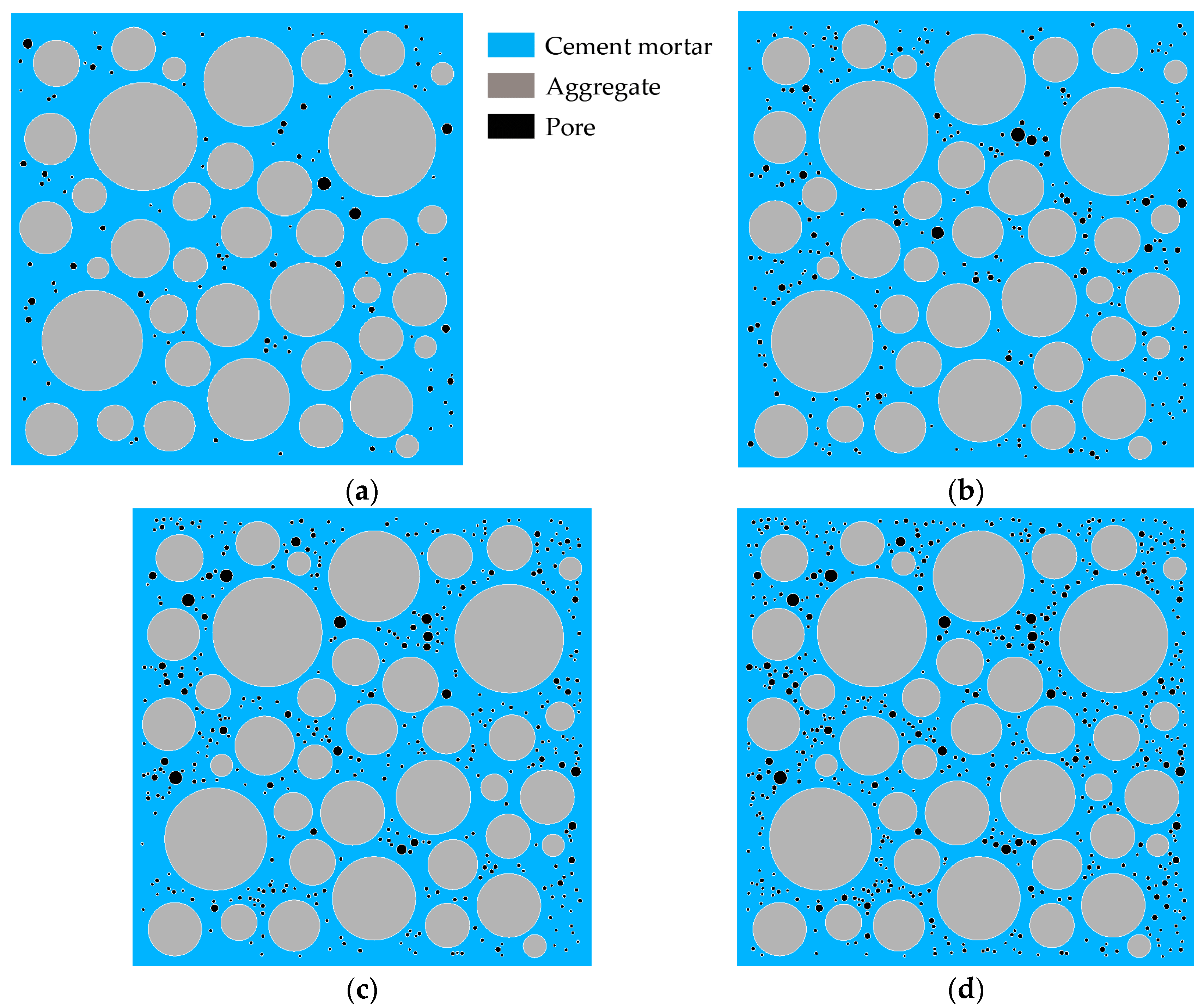
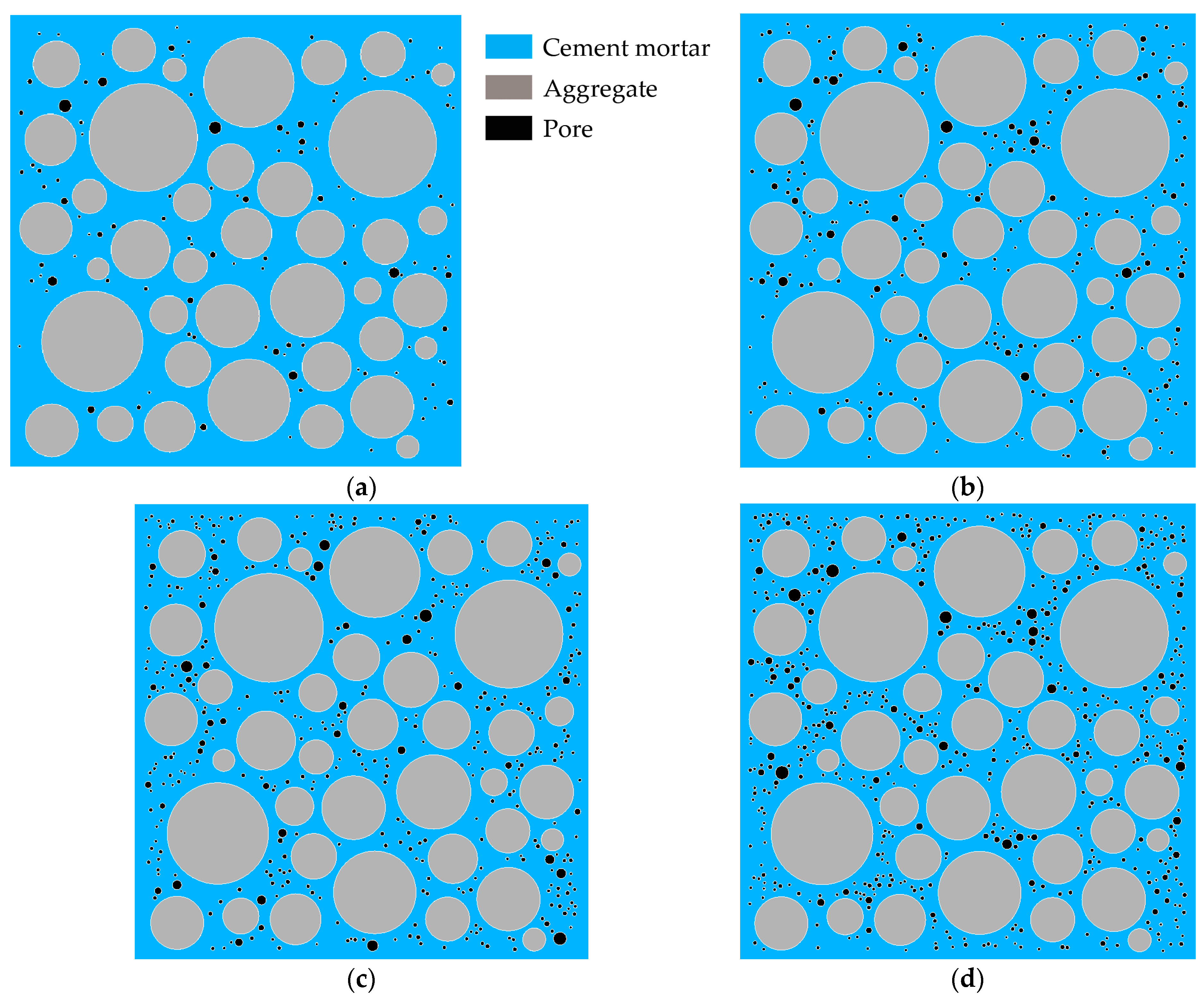
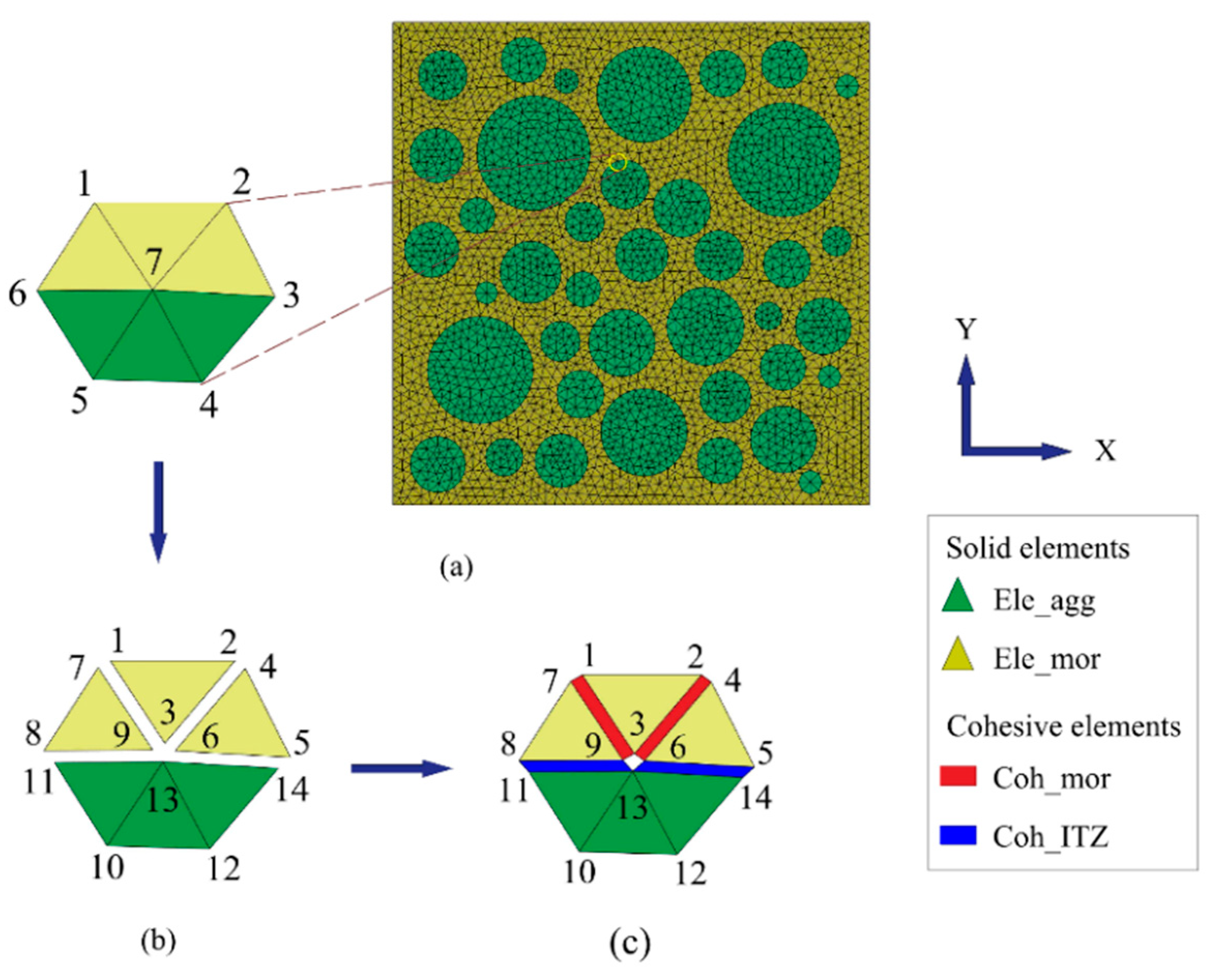

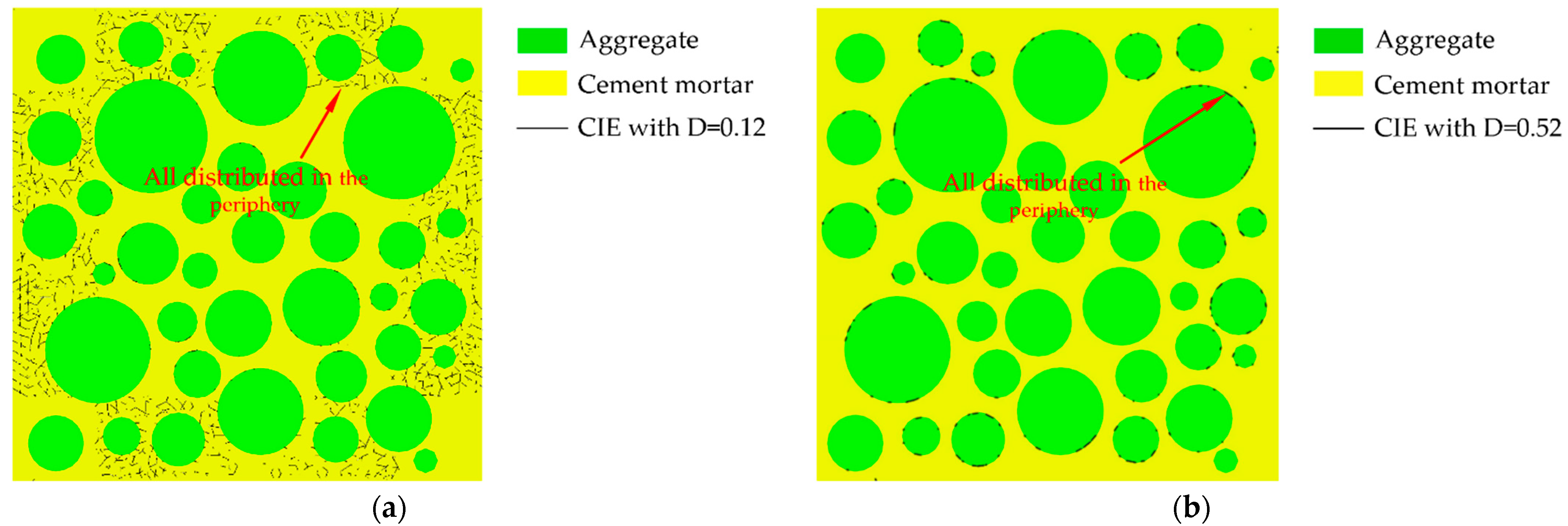
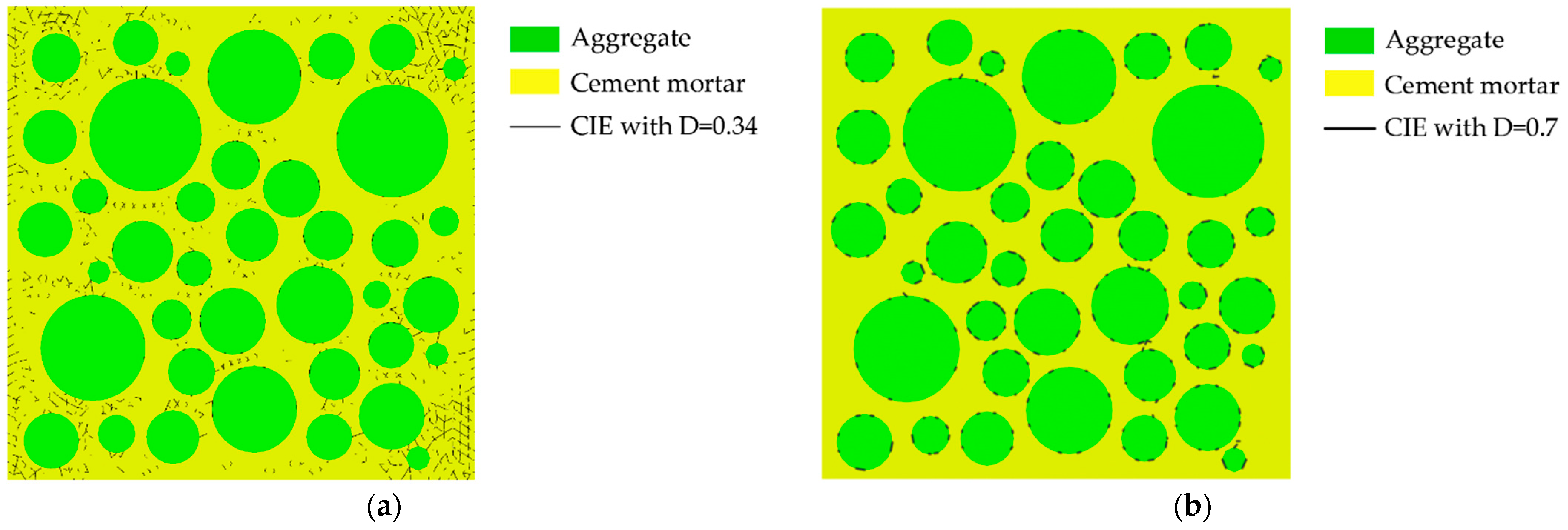

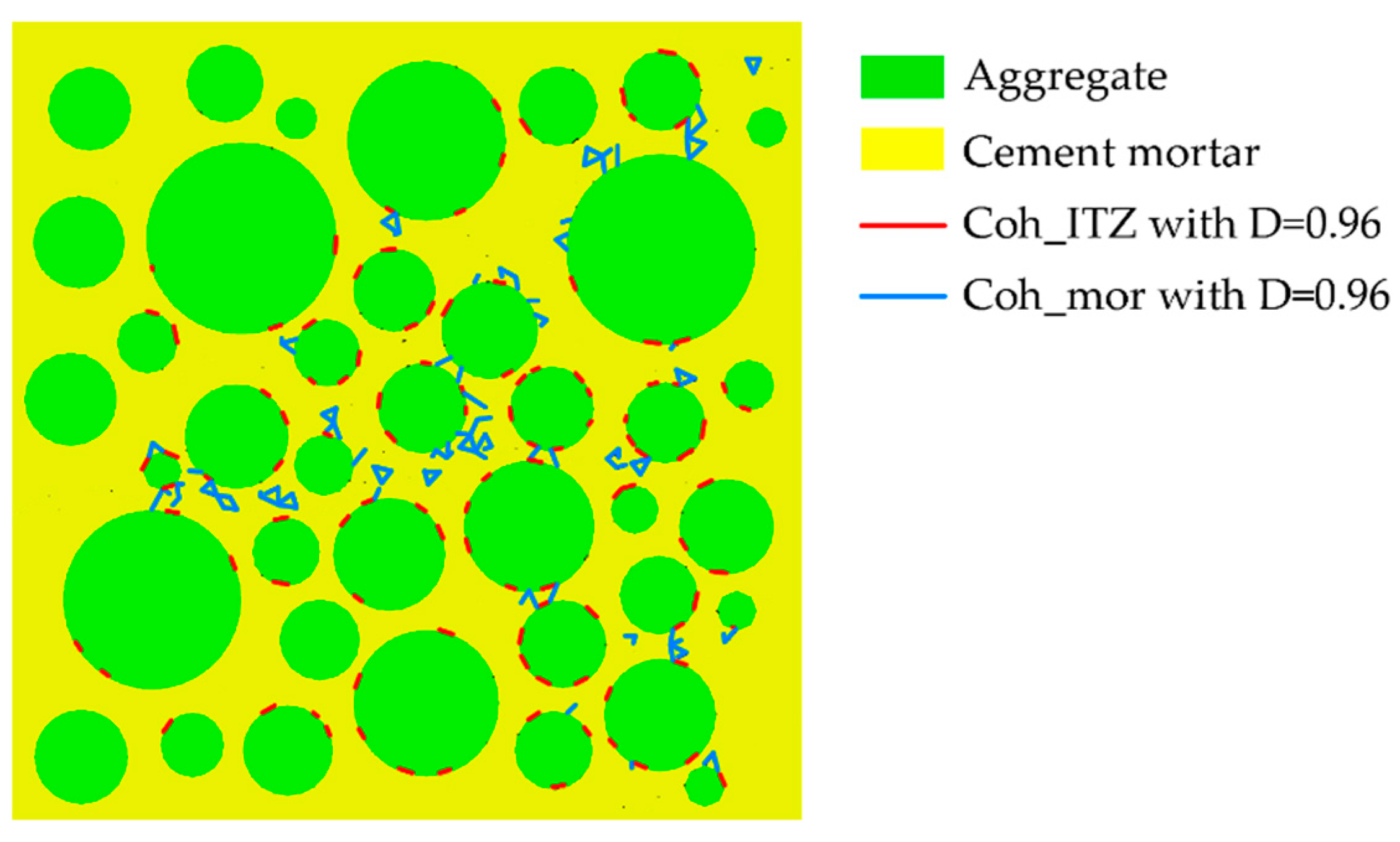
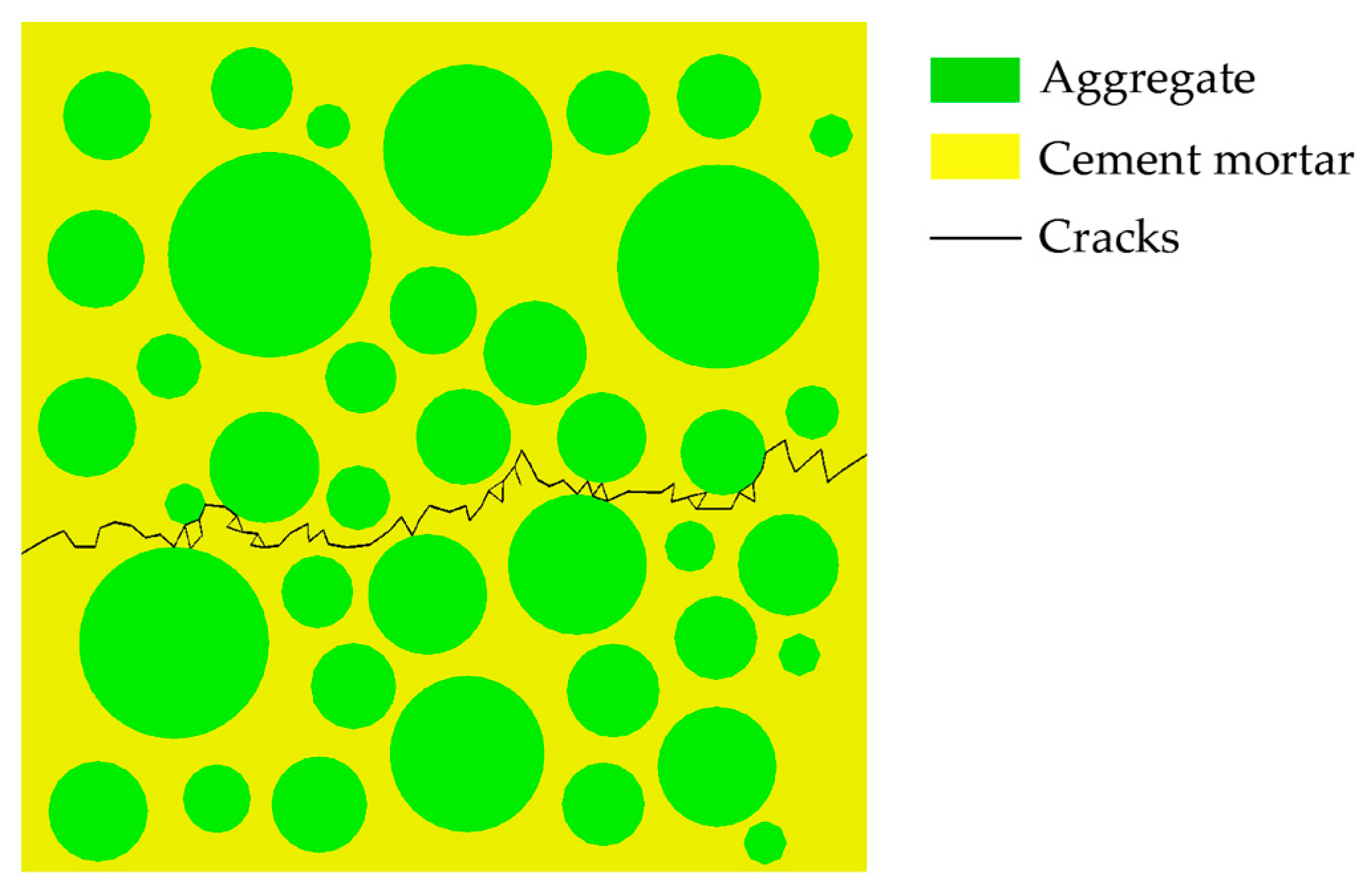
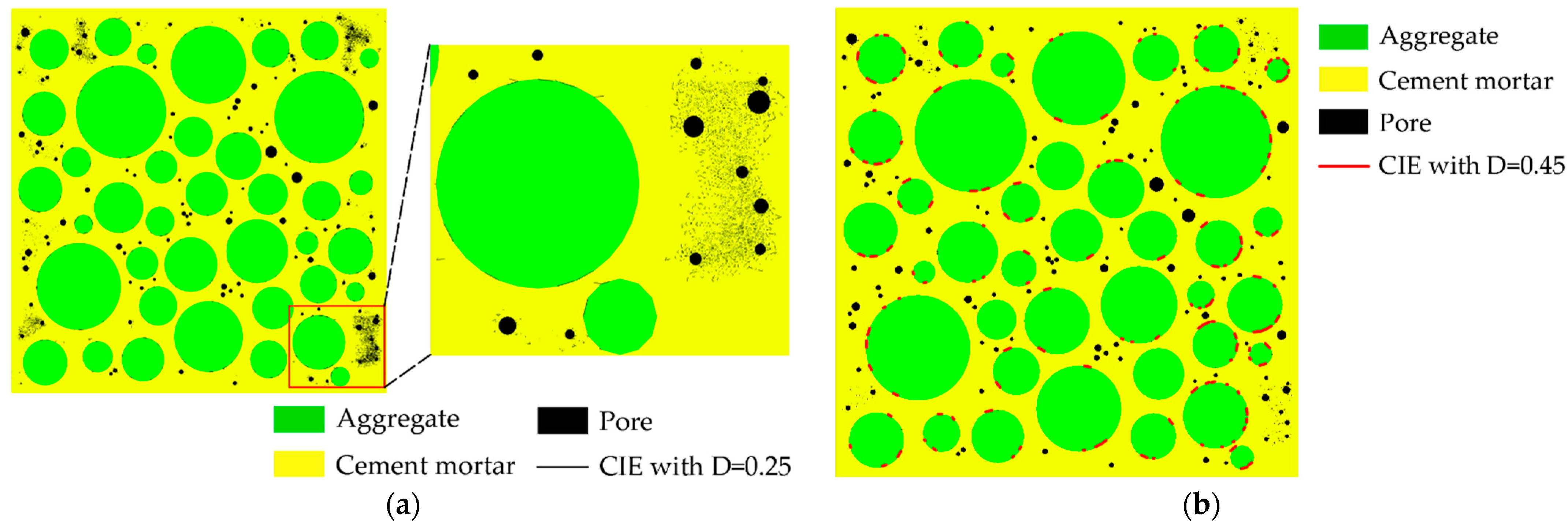

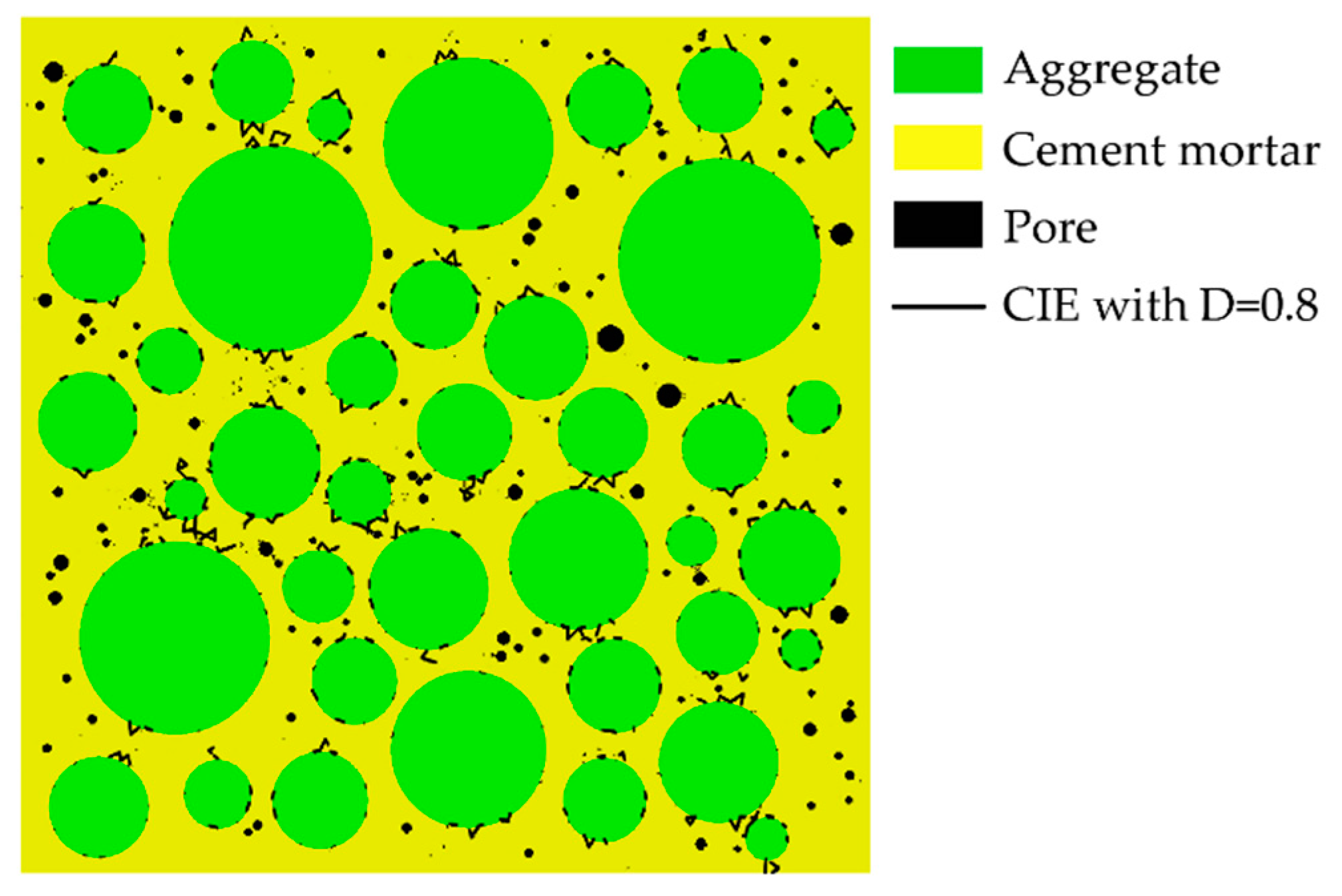


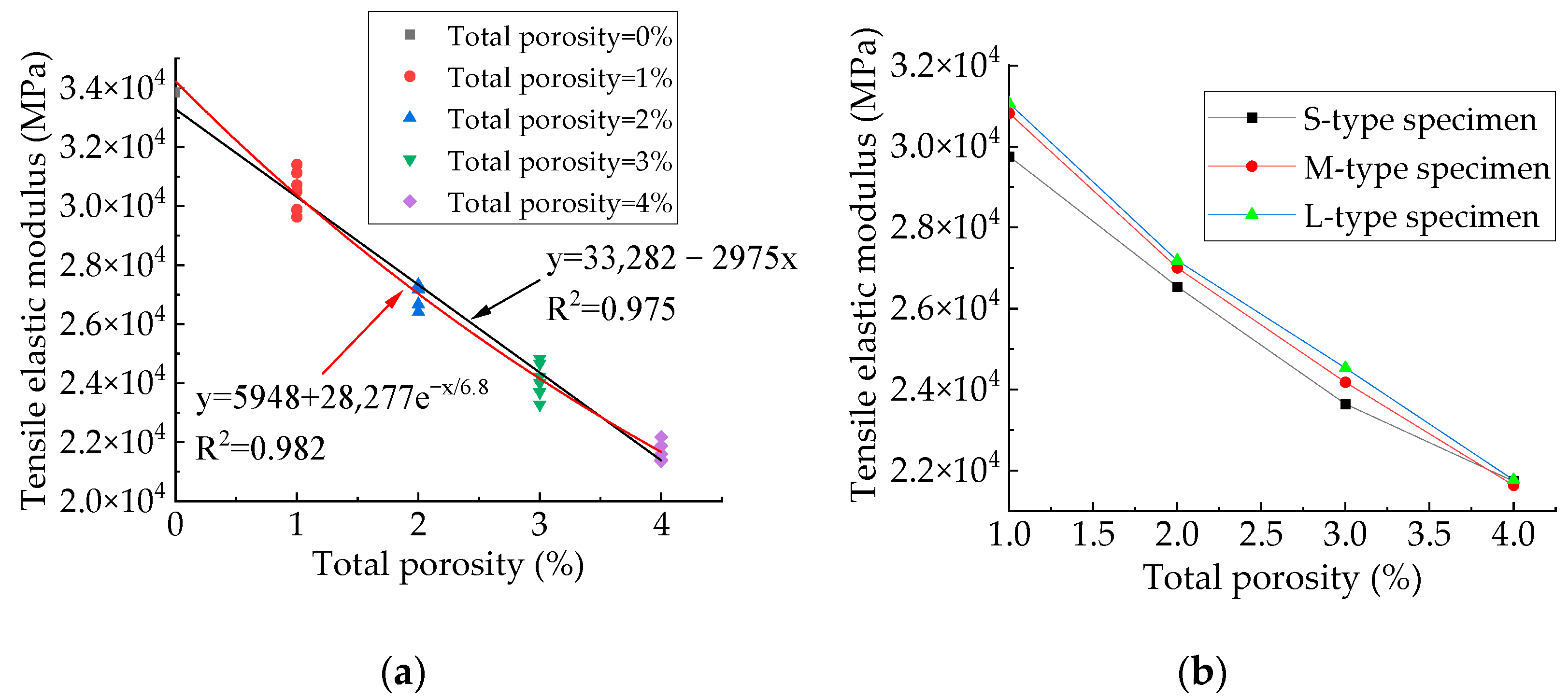
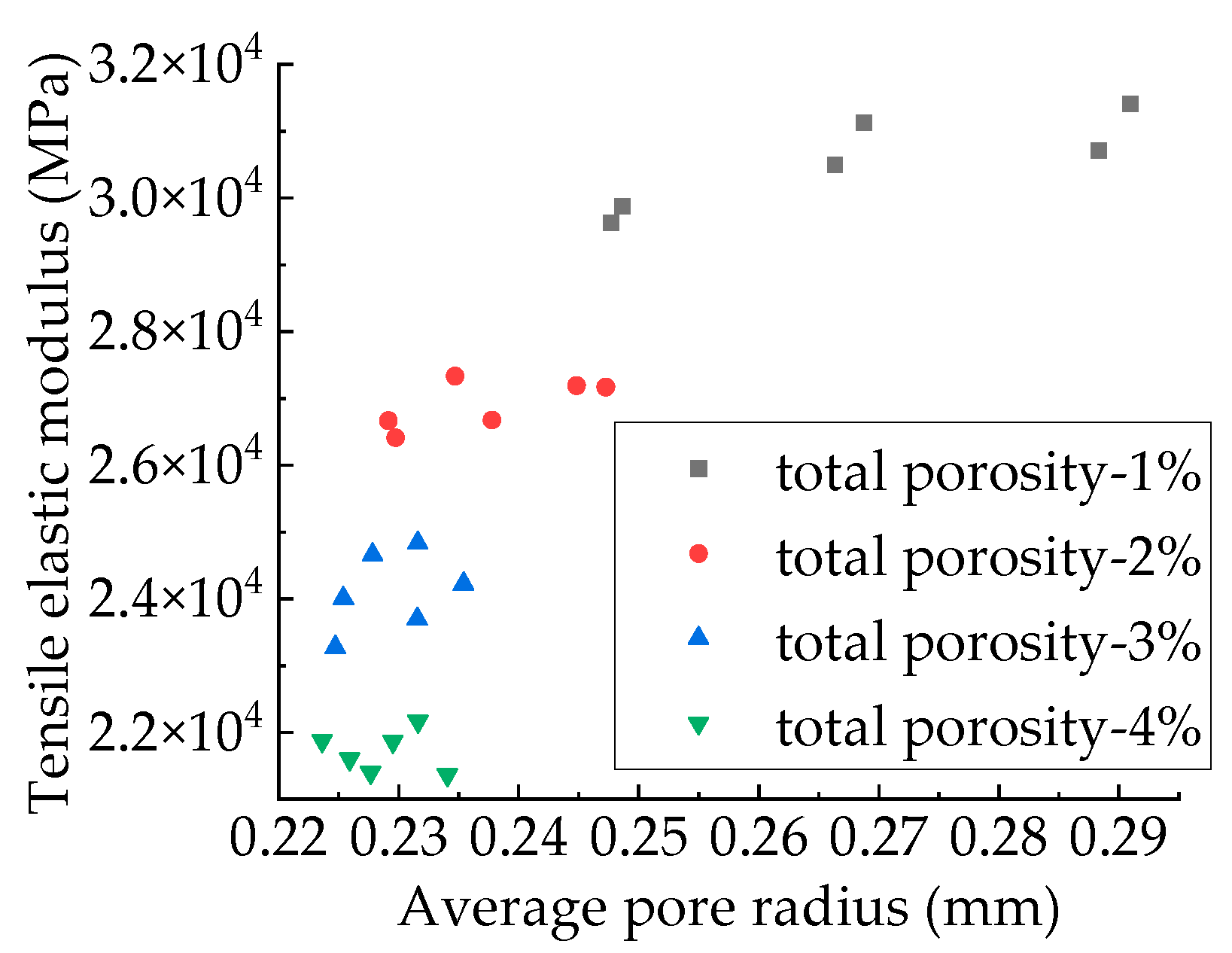


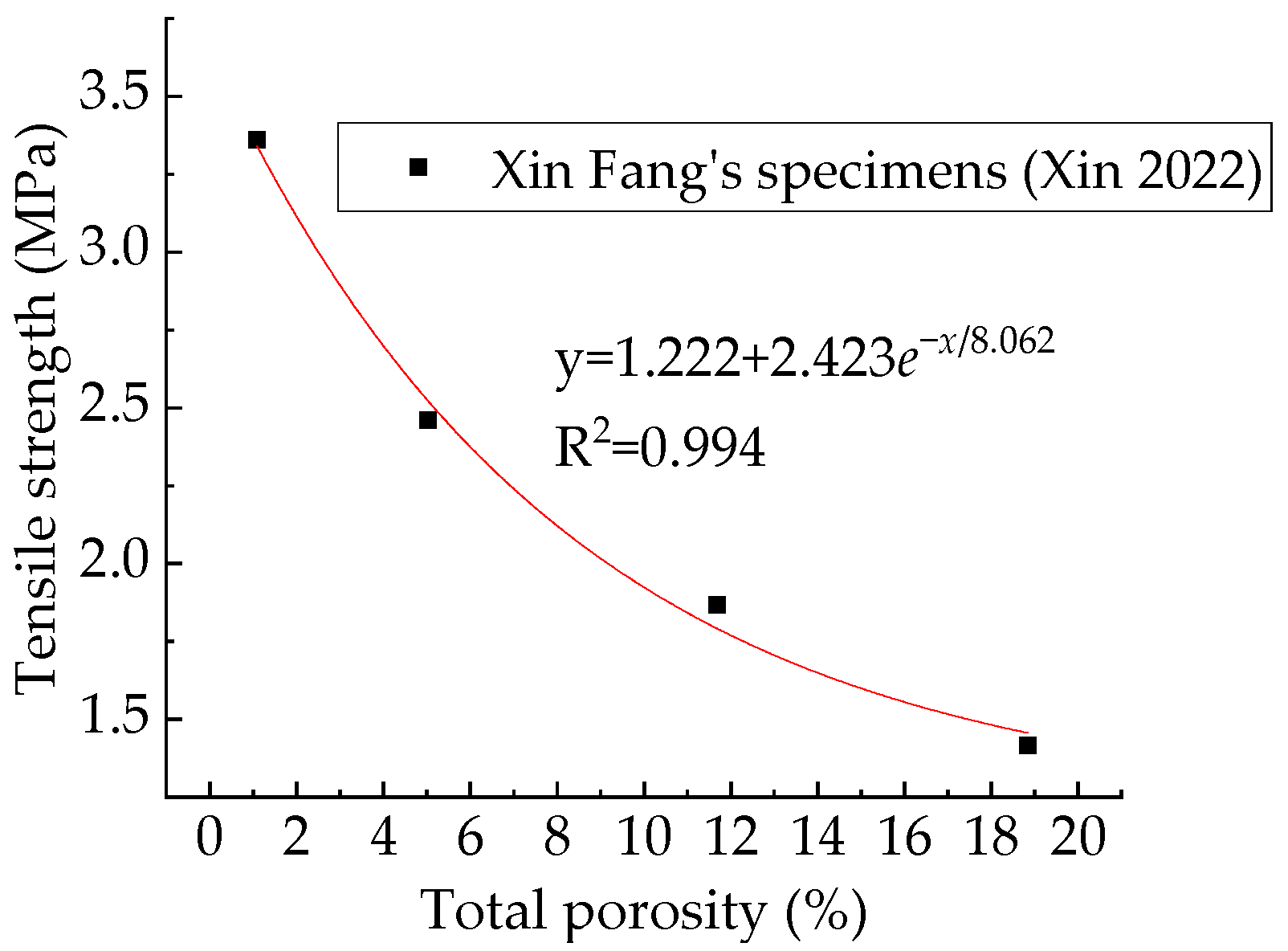
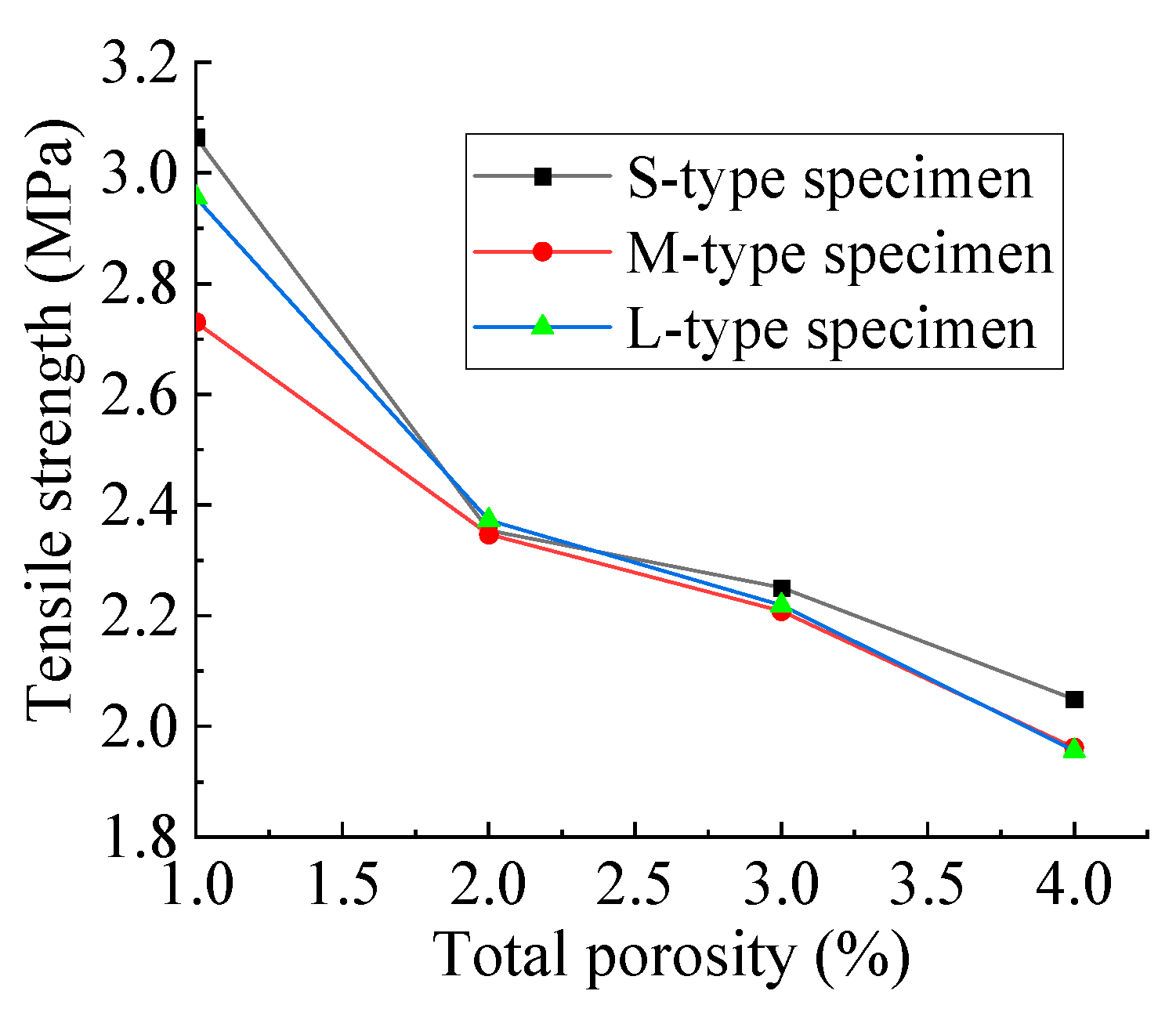
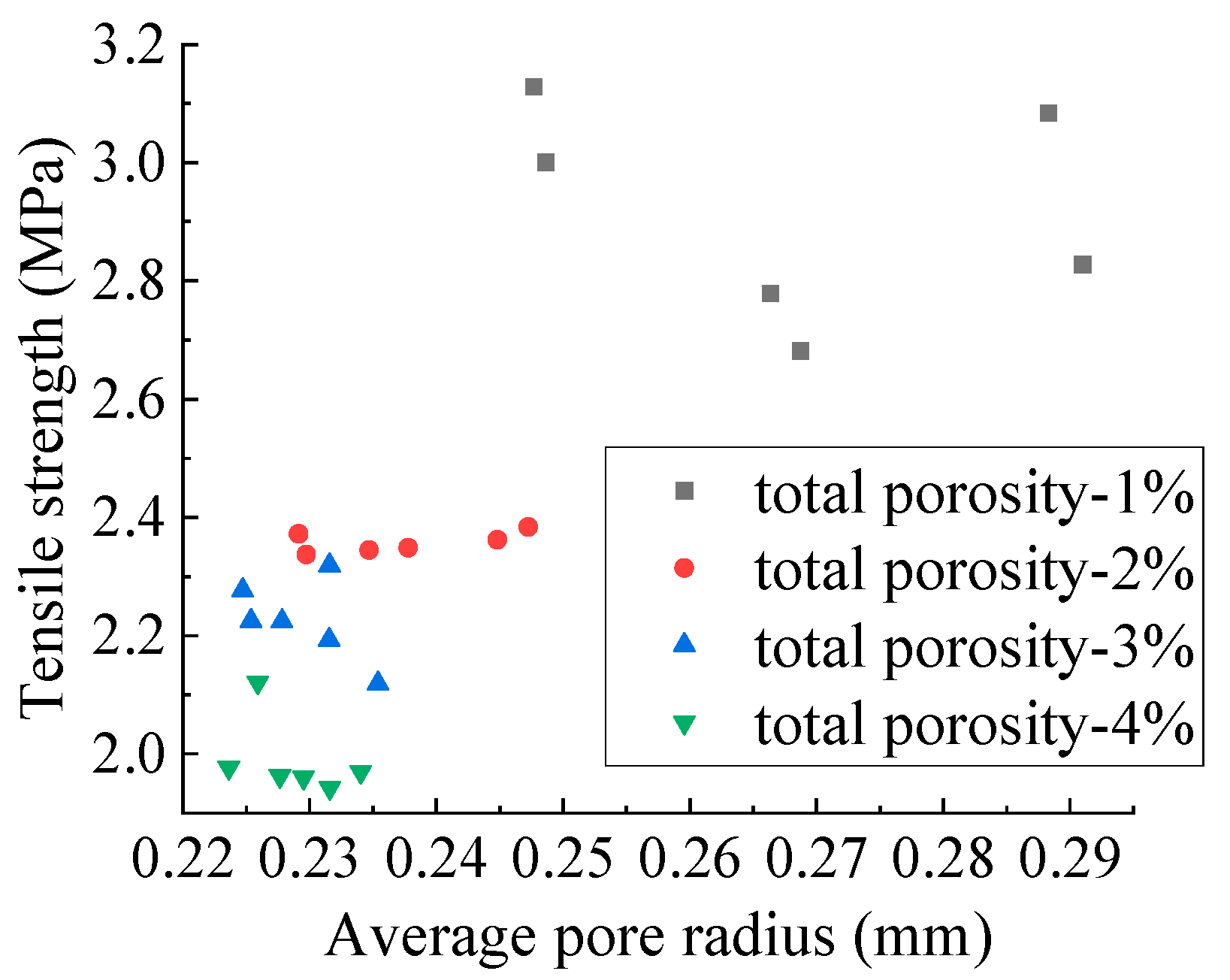



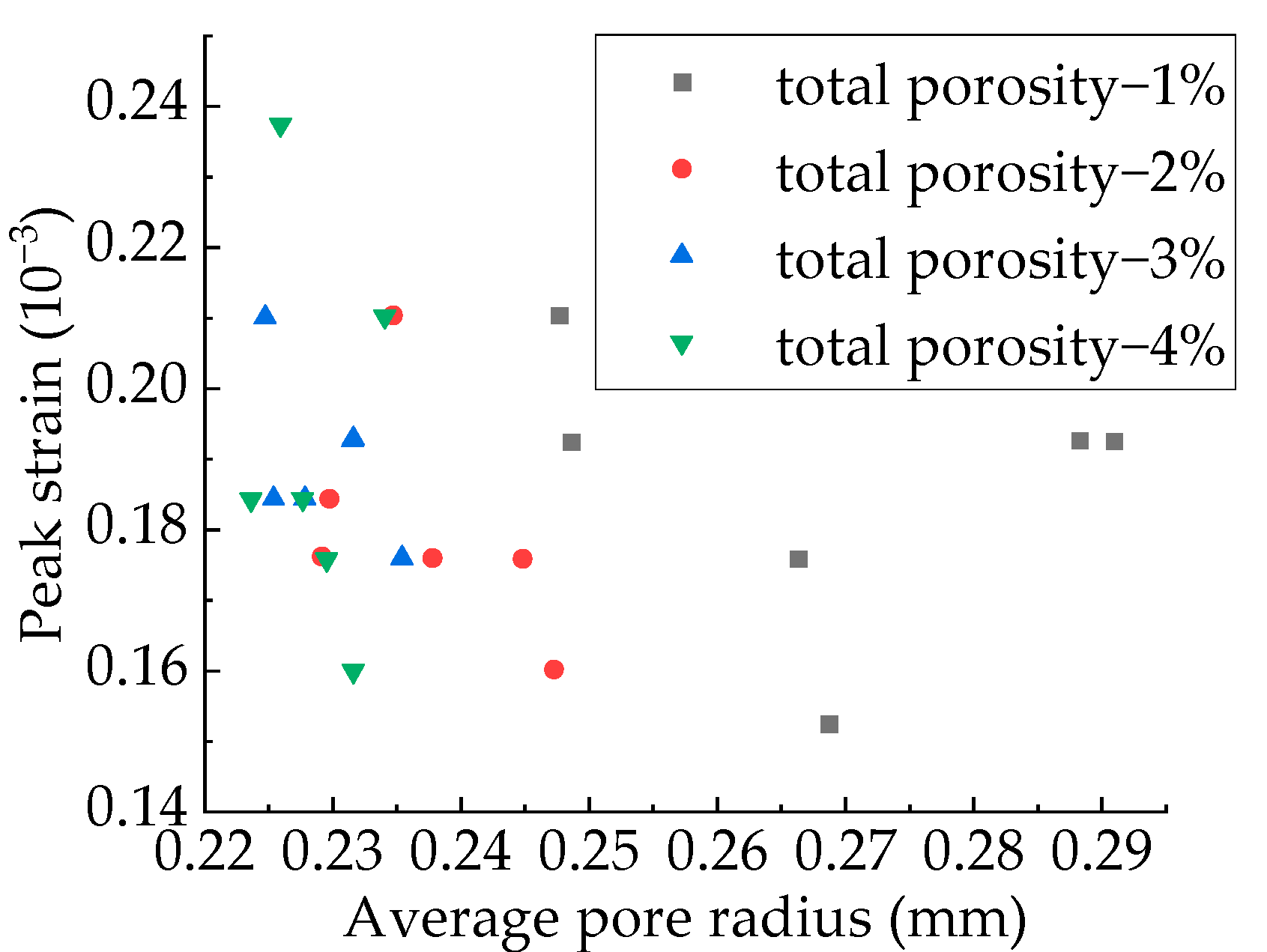

| Diameter Range of Aggregate (mm) | Area of Aggregates (mm2) |
|---|---|
| 19.5 < D < 12.7 | 423.6 |
| 4.75 < D < 9.5 | 600.2 |
| 2.36 < D < 4.75 | 101.2 |
| Sample | Pp [e1, e2] (%) | Pp [e2, e3] (%) | Pp [e3, e4] (%) | Pp [e4, e5] (%) | Total Porosity (%) | Average Pore Radius (mm) | PSSA (mm−1) |
|---|---|---|---|---|---|---|---|
| 0-1 | 0 | 0 | 0 | 0 | 0 | 0 | 0 |
| 1-1-S | 0.4 | 0.3 | 0.14 | 0.15 | 1 | 0.247672 | 0.0684 |
| 1-2-S | 0.4 | 0.3 | 0.14 | 0.15 | 1 | 0.248598 | 0.0681 |
| 1-1-M | 0.305 | 0.3 | 0.2 | 0.195 | 1 | 0.266321 | 0.0615 |
| 1-2-M | 0.305 | 0.3 | 0.2 | 0.195 | 1 | 0.268718 | 0.0614 |
| 1-1-L | 0.21 | 0.3 | 0.25 | 0.24 | 1 | 0.290971 | 0.0555 |
| 1-2-L | 0.21 | 0.3 | 0.25 | 0.24 | 1 | 0.288282 | 0.0565 |
| 2-1-S | 1.1 | 0.5 | 0.28 | 0.12 | 2 | 0.229737 | 0.1541 |
| 2-2-S | 1.1 | 0.5 | 0.28 | 0.12 | 2 | 0.229149 | 0.1531 |
| 2-1-M | 0.965 | 0.49 | 0.34 | 0.205 | 2 | 0.237766 | 0.1439 |
| 2-2-M | 0.965 | 0.49 | 0.34 | 0.205 | 2 | 0.234691 | 0.1450 |
| 2-1-L | 0.83 | 0.48 | 0.4 | 0.29 | 2 | 0.247249 | 0.1354 |
| 2-2-L | 0.83 | 0.48 | 0.4 | 0.29 | 2 | 0.244804 | 0.1359 |
| 3-1-S | 1.75 | 0.52 | 0.42 | 0.31 | 3 | 0.224720 | 0.2303 |
| 3-2-S | 1.75 | 0.52 | 0.42 | 0.31 | 3 | 0.225388 | 0.2299 |
| 3-1-M | 1.655 | 0.485 | 0.505 | 0.355 | 3 | 0.227832 | 0.2243 |
| 3-2-M | 1.655 | 0.485 | 0.505 | 0.355 | 3 | 0.231550 | 0.2228 |
| 3-1-L | 1.56 | 0.45 | 0.59 | 0.4 | 3 | 0.235400 | 0.2141 |
| 3-2-L | 1.56 | 0.45 | 0.59 | 0.4 | 3 | 0.231589 | 0.2176 |
| 4-1-S | 2.28 | 0.99 | 0.49 | 0.24 | 4 | 0.223631 | 0.3157 |
| 4-2-S | 2.28 | 0.99 | 0.49 | 0.24 | 4 | 0.225920 | 0.3144 |
| 4-1-M | 2.135 | 0.97 | 0.57 | 0.325 | 4 | 0.227655 | 0.3060 |
| 4-2-M | 2.135 | 0.97 | 0.57 | 0.325 | 4 | 0.229511 | 0.3044 |
| 4-1-L | 1.99 | 0.95 | 0.65 | 0.41 | 4 | 0.231597 | 0.2961 |
| 4-2-L | 1.99 | 0.95 | 0.65 | 0.41 | 4 | 0.234038 | 0.2951 |
| Bulk Elements | Cohesive Elements | |||
|---|---|---|---|---|
| Aggregate | Mortar | ITZ | Mortar | |
| Density (10−9 t/mm3) | 2.5 * | 2.2 * | 2.2 ^ | 2.2 ^ |
| Elastic modulus (GPa) | 70 ^ | 25 ^ | / | / |
| Poisson’s ratio | 0.2 ^ | 0.2 ^ | / | / |
| Elastic stiffness (MPa/mm) | / | / | 355,000 # | 355,000 # |
| Tensile strength (MPa) | / | / | 1.14 # | 2.28 # |
| Fracture energy (N/mm) | / | / | 0.0114 # | 0.0228 # |
| Sample | Modulus (MPa) | Strength (MPa) | Peak Strain (10−3) |
|---|---|---|---|
| 0–1 | 33,841 | 3.532 | 0.168 |
| 1-1-S | 29,632 | 3.149 | 0.2104 |
| 1-2-S | 29,879 | 3.001 | 0.1925 |
| 1-1-M | 30,500 | 2.779 | 0.1759 |
| 1-2-M | 31,132 | 2.682 | 0.1525 |
| 1-1-L | 31,407 | 2.828 | 0.1926 |
| 1-2-L | 30,715 | 3.084 | 0.1927 |
| 2-1-S | 26,410 | 2.337 | 0.1844 |
| 2-2-S | 26,667 | 2.372 | 0.1762 |
| 2-1-M | 26,675 | 2.349 | 0.1760 |
| 2-2-M | 27,332 | 2.450 | 0.2104 |
| 2-1-L | 27,172 | 2.384 | 0.1602 |
| 2-2-L | 27,193 | 2.362 | 0.1759 |
| 3-1-S | 23,278 | 2.277 | 0.2101 |
| 3-2-S | 24,009 | 2.225 | 0.1844 |
| 3-1-M | 24,663 | 2.224 | 0.1844 |
| 3-2-M | 23,695 | 2.193 | 0.1927 |
| 3-1-L | 24,225 | 2.119 | 0.1760 |
| 3-2-L | 24,837 | 2.319 | 0.1929 |
| 4-1-S | 21,875 | 1.977 | 0.1843 |
| 4-2-S | 21,602 | 2.121 | 0.2374 |
| 4-1-M | 21,403 | 1.963 | 0.1844 |
| 4-2-M | 21,867 | 1.960 | 0.1758 |
| 4-1-L | 22,169 | 1.943 | 0.1600 |
| 4-2-L | 21,363 | 1.970 | 0.2102 |
| Function Type | Fit Function | Correlation Coefficient (R2) |
|---|---|---|
| Linear function | y = 3.197 − 0.322x | 0.866 |
| Exponential function | y = 1.721 + 1.858e−x/2.121 | 0.934 |
| Power function | y = 328.12 − 325.22x0.002 | 0.911 |
| Function Type | Fit Function | Correlation Coefficient (R2) |
|---|---|---|
| Polynomial function | y = 11.369x2 − 7.784x + 3.331 | 0.892 |
| Exponential function | y = 2.129 + 1.780e−x/0.074 | 0.863 |
| Power function | y = 116.215 − 114.845x0.0048 | 0.847 |
| Project | Total Porosity | Average Pore Radius | PSSA | Pp [e1, e2] | Pp [e2, e3] | Pp [e3, e4] | Pp [e4, e5] |
|---|---|---|---|---|---|---|---|
| Elastic modulus | 0.999820 | 0.999759 | 0.999758 | 0.99978717 | 0.999768 | 0.999764 | 0.999760 |
| Tensile strength | 0.74927 | 0.62672 | 0.62156 | 0.75216 | 0.66283 | 0.64477 | 0.63015 |
| Peak strain | 0.55099 | 0.9485 | 0.9402 | 0.745 | 0.869 | 0.909 | 0.9409 |
| Mechanical Properties | 1-Ellipse | 1-2-S |
|---|---|---|
| Modulus (MPa) | 29,118 | 29,879 |
| Strength (MPa) | 2.740 | 3.001 |
| Peak strain (10−3) | 0.1843 | 0.1925 |
Publisher’s Note: MDPI stays neutral with regard to jurisdictional claims in published maps and institutional affiliations. |
© 2022 by the authors. Licensee MDPI, Basel, Switzerland. This article is an open access article distributed under the terms and conditions of the Creative Commons Attribution (CC BY) license (https://creativecommons.org/licenses/by/4.0/).
Share and Cite
Yang, H.; Zhu, E.; Liu, L. Analysis of the Effect of Pore Structure on the Mechanical Properties of Concrete Based on the Meso Numerical Model. Appl. Sci. 2022, 12, 5428. https://doi.org/10.3390/app12115428
Yang H, Zhu E, Liu L. Analysis of the Effect of Pore Structure on the Mechanical Properties of Concrete Based on the Meso Numerical Model. Applied Sciences. 2022; 12(11):5428. https://doi.org/10.3390/app12115428
Chicago/Turabian StyleYang, Hao, Eryu Zhu, and Lei Liu. 2022. "Analysis of the Effect of Pore Structure on the Mechanical Properties of Concrete Based on the Meso Numerical Model" Applied Sciences 12, no. 11: 5428. https://doi.org/10.3390/app12115428






